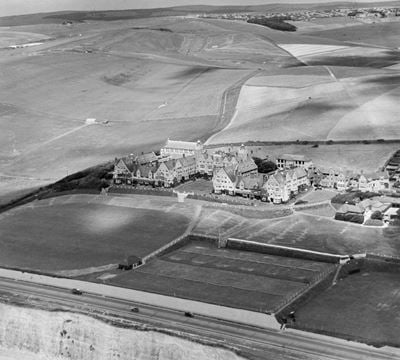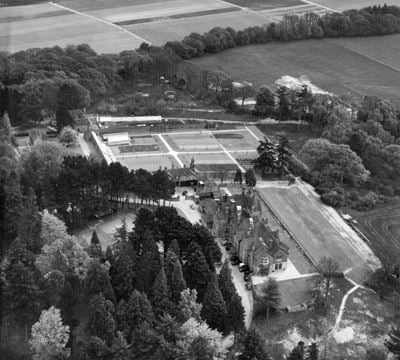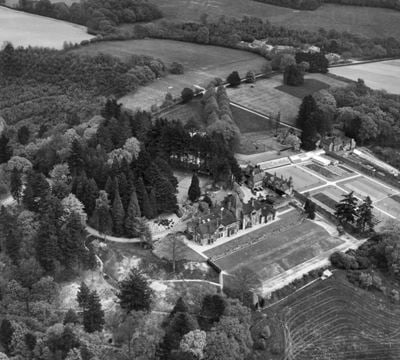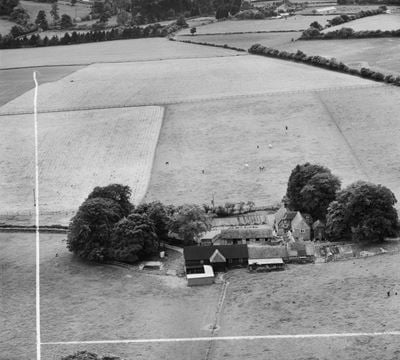South Downs
Explore hidden histories, historic photos, and things you never knew about South Downs from the collections and archives of Historic England.
Discover your local listed buildings and places
Introducing some of South Downs' most historic sites, included in the National Heritage List for England. Some of these captions have been summarised by AI. Click through for the official List entry. Skip this section and go to place by numbers
Hillfort, the possible remains of a Romano-Celtic temple …
Brighton and Hove
The Hollingbury site features a slight univallate hillfort from the Early Iron Age, Bronze Age bowl barrows, and potential remains of a Romano-Celtic temple, illustrating its historical...
Stanmer House
Brighton and Hove
Stanmer House in Brighton is an 18th-century country house by architect Nicholas Dubois. Built for Henry Pelham and expanded in the 19th century, it showcases historical architecture.
Pitshill and the Manor of Dean
Tillington
Pitshill estate includes a Grade II* listed 18th-century house set within mid-19th-century gardens and parklands, historically associated with the Mitford family.
Charleston Manor
Cuckmere Valley
Charleston Manor, once the home of Sir Oswald Birley, features gardens designed by Walter Hines Godfrey. It was a cultural hub hosting the Sussex festival.
Rotherfield Park
Colemore and Priors Dean
Rotherfield Park is a historical estate dating back to the 12th century, featuring picturesque 19th-century gardens and architecture, and has been owned by prominent families, including the...
Former Singleton Railway Station
West Dean
Former railway station of 1880, by T H Myres, consisting of the station house, toilet block and a water tower.
Long Burgh long barrow, Alfriston.
Alfriston
Long Burgh long barrow is a Neolithic monument in Alfriston, representing an ancient communal burial site, with high archaeological potential and national importance due to its rarity and...
Petworth House
Petworth
Petworth House features 16th and 17th-century landscaped grounds by Lancelot Brown, historically linked to the Percy family, Somerset Duke, and artist J.M.W. Turner.
Blackdown Park
Lurgashall
Blackdown Park, an early to mid-19th-century garden, features historic elements from the 18th century and earlier, enriched with 20th-century additions, located near Haslemere.
Anne of Cleves House Wings Place
Ditchling
Anne of Cleves House, a late 16th-century timber-framed building in Ditchling, features a distinctive L-shape, ornate timbering, period fireplaces, and historic architectural details.
Bronze Age and Anglo-Saxon barrow cemeteries south of Jug…
Kingston Near Lewes
The Bronze Age and Anglo-Saxon barrow cemeteries south of Juggs Road are important historical elements, showcasing burial practices and early social structures.
Remains of Exceat parish church: part of the former medie…
Cuckmere Valley
Exceat parish church, a medieval site, highlights England's varied settlement history in the East Wessex sub-Province, with archaeological insights into rural life post-Norman conquest.
Burpham camp
Burpham
Burpham camp is an Iron Age fort reoccupied as an Anglo-Saxon burh, preserving significant archaeological data with limited modern disturbance.
The Devil's Jumps round barrow cemetery
Elsted and Treyford
The Devil's Jumps round barrow cemetery is a well-preserved Bronze Age site featuring rare bell barrows and common bowl barrows, indicating aristocratic and diverse burial practices.
Lavington Park
Duncton
Lavington Park's estate dates back to the late 16th century, with developments in the 18th and 19th centuries, notable for historical figures like Bishop Wilberforce and Cardinal Manning.
Motte and bailey castle in Pulborough Park
Pulborough
Motte castles, including Pulborough Park's example, were Norman fortifications serving as strongholds and administration centers, significant for studying Norman Britain and feudal system...
Devil's Dyke hillfort
Poynings
Devil's Dyke hillfort is a prime example of a large univallate hillfort reflecting Iron Age society's organization and labor mobilization, illustrating reuse and attraction trends in later...
Goodwood House
Boxgrove
Goodwood House features an 18th-century garden, expanded with ornamental and late 20th-century additions, within a historic park of medieval origin associated with the Dukes of Richmond.
Avington Park
Itchen Valley
Avington Park has origins in medieval times and the 17th century, with major developments in the 18th century by the third Duke of Chandos.
Hillfort, a beacon and dewpond on Ditchling Beacon
Ditchling
Ditchling Beacon hillfort, a Late Bronze Age to Early Iron Age enclosure, illustrates ancient defensive architecture and agricultural evolution in Sussex.
King Edward VII Hospital
Easebourne
King Edward VII Hospital was a tuberculosis sanatorium founded by King Edward VII in 1906, featuring gardens designed by Gertrude Jekyll for therapeutic activities.
Stansted Park
Stoughton
Stansted Park features gardens and parkland dating from the late 17th century, developed further through the centuries with contributions from notable figures like Lancelot Brown.
Warnford Park
Warnford
Warnford Park, featuring a mid-18th-century landscape possibly designed by Lancelot Brown, was a setting for a country house, now demolished, with remaining pleasure grounds.
Martin Down style enclosure, bowl barrow, Iron Age hillfo…
Upper Beeding
The Martin Down style enclosure on Thundersbarrow Hill is a rare Late Bronze Age monument, showcasing ancient settlement patterns alongside an Iron Age hillfort and a Roman village.
Roman road at Chapel Common
Milland
Roman roads, essential for Roman mail and commerce, remain well-preserved at Chapel Common, offering insights into Roman engineering and historical land use.
Roman road and 18th century coaching road N of Pyecombe c…
Pyecombe
The site at Welstonbury Hill features a Roman road and a late 18th-century coaching road, showcasing ancient civil engineering and road travel evolution.
Swing Bridge Over River Ouse
Southease
Swing bridge. 1880, designed in 1878, by Henry E Wallis (CE) of Westminster, and constructed by Shaw & Co., with C20 timber replacement and safety additions.
Lewes Quaker Meeting House
Lewes
Quaker Meeting House built in 1784 on a site which had been a Quaker burial ground since 1697. It has been extended three times, in 1801, 1860 and 1977-8.
The Vandalian Tower, Up Park
Harting
The Vandalian Tower in Uppark is a notable part of an 18th-century garden designed by Lancelot Brown, symbolizing its owner's status and linked to the Hellfire Club.
Robertson War Memorial Bequest Obelisk at Michel Dene, Cr…
East Dean and Friston
First World War memorial marker.
Glynde Place
Glynde
Glynde Place, built in 1568-69 by William Morley, underwent key alterations by Bishop Richard Trevor in the 1750s, with ongoing historic family ownership and restoration efforts.
Lewes Castle
Lewes
Lewes Castle, noted for its double motte structure, showcases the diversity of medieval fortifications and remains significant for archaeological study and public engagement.
Wiggonholt Church
Parham
Wiggonholt Church, dating from the 13th century, features a chancel and nave, a western bell-turret, and a south porch, illustrating historical architectural significance.
West Dean College West Dean Park
West Dean
West Dean College was originally built by James Wyatt for Lord Selsey in 1804 and later expanded. King Edward VII frequently visited William James here.
Stanmer Park
Ditchling
Stanmer Park is an 18th-century landscape park in Sussex, designed by Charles Bridgeman and Nicholas Dubois around an early 18th-century country house.
Uppark (National Trust)
Harting
Uppark, built around 1689 by Ford Lord Grey of Warke, features interior decor from the 1770s. Emma Hart, Lady Hamilton, and H.G. Wells were notable residents.
Romano-British villa at Randolph's Farm
Hurstpierpoint and Sayers Common
Romano-British villas were large rural estates with residential, agricultural, and industrial buildings, reflecting Romanized lifestyle and economic history in Britain.
Burton Park
Barlavington
Burton Park features 19th and early 20th-century gardens in an 18th-century park. Historically owned by prominent families, it now serves private residential purposes.
Explore more
Search for more listed placesSouth Downs through time
This timeline shows the first period of use for buildings and places on the National Heritage List for England, just one of the details recorded for every list entry. Click around to see how South Downs changes over time. Skip this section and go to aerial photos
Prehistoric Before AD 43
Prehistory covers a million years of human occupation before the Roman invasion, from hunter-gatherers of several human species, including Neanderthals, to more recent herders and farmers. It was a time of developing technologies and belief systems, involving contact with and migration from Europe, all reflected in the variety of artefact and monument types characteristic of particular prehistoric periods.
Roman AD 43 to AD 410
Britain was invaded by four legions of the Roman army in AD 43, who relatively rapidly conquered England from landing points in Kent. Parts of Wales and Scotland soon followed.
Roman culture brought urbanism, monumental buildings, wide-ranging religious beliefs, writing, and strong social hierarchy. The Roman administrative system was withdrawn in AD 410.
Early medieval AD 410 to AD 1066
This period, often associated in England with Anglo-Saxons and Vikings, saw a reduction in urban living from the Roman period and increased migration from northern Europe.
Traces of this period can be found in cemeteries, particularly in artefacts and in some of the very early churches, as this period also saw the growth of Christianity in Britain.
Medieval AD 1066 to AD 1540
This period, sometimes known as the Middle Ages, began with the Norman invasion in AD 1066. It saw a significant rise in military and defensive buildings such as castles and earthworks, as well as religious houses dominating a largely agricultural landscape.
The monarchy and Church dominated the period, which also saw the break with the Roman Catholic Church and the English reformation.
Post medieval AD 1540 to AD 1901
The Post-Medieval period brought seismic changes to life in England, with religious reformation leading to the democratization of worship and the destruction of hundreds of religious houses.
In parallel, there was a huge expansion of scientific study and enlightenment that permanently altered the nation's social structure and landscape. Industrialization and mass production lead to wider global trade, emigration, and immigration.
20th century AD 1901 to AD 2000
The 20th century saw an incredible expansion of England's transport networks, with suburban growth shadowing rapid infrastructural expansion. The establishment of state schools, hospitals, and modern technical colleges, with new architectural styles, radically changed the appearance of towns and cities.
Two catastrophic world wars and the 1918 pandemic also brought unprecedented change, altering England's built environment and social structures forever.
Prehistoric Before AD 43
Prehistory covers a million years of human occupation before the Roman invasion, from hunter-gatherers of several human species, including Neanderthals, to more recent herders and farmers. It was a time of developing technologies and belief systems, involving contact with and migration from Europe, all reflected in the variety of artefact and monument types characteristic of particular prehistoric periods.
Roman AD 43 to AD 410
Britain was invaded by four legions of the Roman army in AD 43, who relatively rapidly conquered England from landing points in Kent. Parts of Wales and Scotland soon followed.
Roman culture brought urbanism, monumental buildings, wide-ranging religious beliefs, writing, and strong social hierarchy. The Roman administrative system was withdrawn in AD 410.
Early medieval AD 410 to AD 1066
This period, often associated in England with Anglo-Saxons and Vikings, saw a reduction in urban living from the Roman period and increased migration from northern Europe.
Traces of this period can be found in cemeteries, particularly in artefacts and in some of the very early churches, as this period also saw the growth of Christianity in Britain.
Medieval AD 1066 to AD 1540
This period, sometimes known as the Middle Ages, began with the Norman invasion in AD 1066. It saw a significant rise in military and defensive buildings such as castles and earthworks, as well as religious houses dominating a largely agricultural landscape.
The monarchy and Church dominated the period, which also saw the break with the Roman Catholic Church and the English reformation.
Post medieval AD 1540 to AD 1901
The Post-Medieval period brought seismic changes to life in England, with religious reformation leading to the democratization of worship and the destruction of hundreds of religious houses.
In parallel, there was a huge expansion of scientific study and enlightenment that permanently altered the nation's social structure and landscape. Industrialization and mass production lead to wider global trade, emigration, and immigration.
20th century AD 1901 to AD 2000
The 20th century saw an incredible expansion of England's transport networks, with suburban growth shadowing rapid infrastructural expansion. The establishment of state schools, hospitals, and modern technical colleges, with new architectural styles, radically changed the appearance of towns and cities.
Two catastrophic world wars and the 1918 pandemic also brought unprecedented change, altering England's built environment and social structures forever.
Aerial photos of South Downs
Aerial photography helps reveal secrets of England's changing landscapes that are impossible to see from the ground. Skip this section and go to archive images

Bramdean
Woodcote Manor House, Bramdean, 1938

Bramdean
Woodcote Manor House, Bramdean, 1938

Roedean
Roedean School, Roedean, 1920

Roedean
Roedean Girls' School, Roedean, 1937

Fernhurst
Plant Protection Ltd Fernhurst Research Station at Verdley Place, Fernhurst, 1951

Fernhurst
Plant Protection Ltd Fernhurst Research Station at Verdley Place, Fernhurst, 1951

Bishop'S Waltham
Bishop's Down Farm, Bishop's Waltham, 1952

Bishop'S Waltham
Bishop's Down Farm, Bishop's Waltham, 1952

Arundel
Arundel Castle and the Cathedral of Our Lady, Arundel, 1920

Arundel
Arundel Castle, Arundel, 1953
South Downs in the Historic England Archive
The Historic England Archive cares for over 15 million images, dating from the 1850s to the present day. Discover stunning images of South Downs' past. Skip this section and go to stories about heritage
Charles George Harper Collection
Slindon Common, Arun, West Sussex
Date created: 1892 - 1933
Exterior view of the Dog and Partridge Inn on Slindon Common
Eric de Mare
Arun, West Sussex
Date created: 1945 - 1980
Interior view of Arundel Castle showing a detail of mahogany panelling in the Gothic Library, which dates from 1801.
John Gay Collection: London
Richmond Park, Kingston Upon Thames, Greater London Authority
Date created: Jan 1962 - May 1964
A herd of deer lie on the grass in the shade at Richmond Park.
John Gay Collection: Modern Architects
Coopersale, Epping Forest, Essex
Date created: 1970 - 1979
The modern terrace of houses at 60 to 63 Parklands, part of a late 20th century housing estate at Coopersale
John Gay Collection: Rural Life
Chichester, West Sussex
Date created: 1950 - 1965
A view of E Martin and Sons' boat yard in the Chichester area of West Sussex, looking from an elevated position out towards a tidal area, probably the...
John Gay Collection: Counties
Chichester, West Sussex
Date created: Early 1950s
A young boy sitting on a flight of steps leading up to Cowdray House, with people walking by
John Laing Collection
Horsham, West Sussex
Date created: 02 Jul 1951
Lorries in the lorry loading bay at Shoreham Cement Works being loaded with sacks of Blue Circle Ferrocrete
Nigel Temple Collection of Postcards of Parks and Gardens
Rowlands Castle, East Hampshire, Hampshire
Date created: 1900 - 1905
GENERAL VIEW SHOWING RUSTIC BRIDGE
Eric de Mare
Arun, West Sussex
Date created: 1945 - 1980
Interior view of Arundel Castle showing a detail of decoration carved in mahogany in the Gothic library, which dates from 1801.
John Gay Collection: London
Richmond Park, Kingston Upon Thames, Greater London Authority
Date created: Jan 1962 - May 1964
A herd of deer lie in the long grass at Richmond Park.
John Gay Collection: Rural Life
Chichester, West Sussex
Date created: 1950 - 1965
A view of a cricket match, showing players and onlookers taking a break beside a clubhouse at the edge of the pitch, with a woman serving food and...
John Laing Collection
Horsham, West Sussex
Date created: 25 Jun 1951
The interior of the cement grinding mills at Shoreham Cement Works
Stories about heritage in your local area
Historic England publishes news, blogs, research, videos, and podcasts celebrating England's rich heritage. Discover the stories we have about South Downs. Skip this section and go to education
Narrative Structures: England’s Literary History in 11 Places
Mentions Jane Austen's House
Discover the historic sites in England where famous writers found their inspiration.
Empress Matilda and ‘The Anarchy’
Mentions Arundel Castle
A look at the career of 12th century claimant to the English throne the Empress Matilda.
Fashionable Fakery: 8 Fantastical Follies
Mentions Clayton Tunnel North Portal Tunnel Cottage
Follies litter our 18th century landscapes, representing the humour and eccentricity of the financier. Here we take a look at 8 fantastical features.
6 Sites of Memory for Overseas War Heroes
Mentions The Chattri
The First and Second World Wars were truly global in scale and involvement.
A Brief Introduction to the Women’s Institute
Mentions The Fox Goes Free
Britain’s first WI was formed in Wales in September 1915, and the first in England followed soon afterwards, at Charlton, West Sussex.
A Brief Introduction to Ancient Paths and Highways
Mentions Romano-British enclosure and later hollow ways on Twyford Down, Roman road and 18th century coaching road N of Pyecombe church
From main roads connecting towns and cities to meandering green lanes and mysterious paths to nowhere, our highways and byways are steeped in history.
6 Remarkable First World War Memorials
Mentions War Memorial
1. The Response, Newcastle Designed by Sir William Goscombe John, unveiled 1923.
7 Inspiring Writers’ Retreats
Mentions Monks House
Many of our favourite author’s writing spots are protected.
The Lost Roman Road From Chichester To Arundel
Mentions South Downs
Analysis of lidar and aerial photography leads to the rediscovery of a long-speculated route of a Roman Road.
Research Reports Roundup August 2023
Mentions South Downs
A roundup of recent research reports added to our database in June 2023 to August 2023, displayed by heritage themes.
Heritage at Risk in the South East Revealed
Mentions South Downs
25 sites have been saved and 15 sites added to the Heritage at Risk Register 2023 in the South East of England.
The South Downs Explored From Above: A Landscape of Rich Archaeology Revealed
Mentions Part of Western Brow round barrow cemetery and an Anglo-Saxon barrow field 700m south of Westmeston Farm, South Downs
Aerial imagery used to map hundreds of archaeological sites across part of the South Downs.
11 Remarkable Historic Pubs Given Protection
Mentions The Harrow Inn
A project to save rare historic pub interiors sees 11 remarkable pubs being newly listed, having their listing upgraded or list entry updated.
1930s Modernist Architectural Gem Listed
Mentions South Downs
Bentley Wood, East Sussex, by Serge Chermayeff has been listed at Grade II on the advice of Historic England.
National Collection of Sir Herbert Baker’s War Memorials Recognised
Mentions Blackmoor War Memorial Cloister, Cross, and Fountain
15 First World War memorials by Sir Herbert Baker have been listed or upgraded to commemorate the centenary of the Commonwealth War Graves Commission.
Heritage at Risk 2016
Mentions South Downs
The Heritage at Risk Register 2016 is published today, providing our annual insight into the state of England’s most valued historic places.
Four Buildings Re-listed to Celebrate Their Role in the History of the Women’s Institute
Mentions The Fox Goes Free
The re-listings of four buildings celebrate the story of the WI and mark the centenary of the first WI meeting in England.
South Downs' social history through photos
Over 10,000 images from the Historic England Archive have been specially selected and re-captioned for teachers, students, and anyone who wants to learn more about their local area. Skip this section and go to grant-aided places
Yeoman's House, Bignor, West Sussex
Period: Tudor (1485 - 1602)
The Yeoman's House dates is a 15th-century thatched and timber-framed cottage with jettied overhangs.
Yeoman's House, Bignor, West Sussex
West Ashling Mill, Funtington, West Sussex
Period: 1930s (1930 - 1938)
Also known as Hackett's Mill.
West Ashling Mill, Funtington, West Sussex
War Memorial, High Street, Lewes, East Sussex
Period: World War One (1914 - 1919)
This First World War memorial was built in 1920 by the architects March and March.
War Memorial, High Street, Lewes, East Sussex
Tudor House, Petworth, West Sussex
Period: Stuart (1603 - 1713)
This house, together with Squire's Holt on Church Street, formed a large house which was the home of the Daintrey family.
Tudor House, Petworth, West Sussex
Tags
Toll Gate, Southerham, East Sussex
Period: Victorian (1837 - 1901)
Two women standing by the toll gate and house at Southerham. It looks a bleak and isolated location.
Toll Gate, Southerham, East Sussex
The Yeoman's House, Bignor, West Sussex
Period: Medieval (Middle Ages) (1066 - 1484)
A detail of the exterior showing wattle and daub panels.
The Yeoman's House, Bignor, West Sussex
Period: Medieval (Middle Ages) (1066 - 1484)
A detail of windows and timber framing.
The Old Girls School, Petworth, West Sussex
Period: Georgian (1714 - 1836)
The Old Girls School was originally built as a Unitarian chapel in 1819.
Visit grant-aided places near you
These places and buildings have been helped by Historic England's financial grants. Find local heritage in your neighbourhood that you never knew existed! Please note that opening times may vary. Skip this section and go to related locations
Amberley Museum, New Barn Road, Amberley, Arundel, West Sussex
The Bagmender's shed at Amberley Museum is a single-story building once used by a bagmender working at the quarry.
Maison Dieu (Greyfriars), Mill Road, Arundel, West Sussex
The Former Hospital of the Holy Trinity, dating back to 1395, features some ruinous walls made of coursed rubble, including flints and clunch.
Discover more
Ready for more local stories? Take a look at these other places nearby


